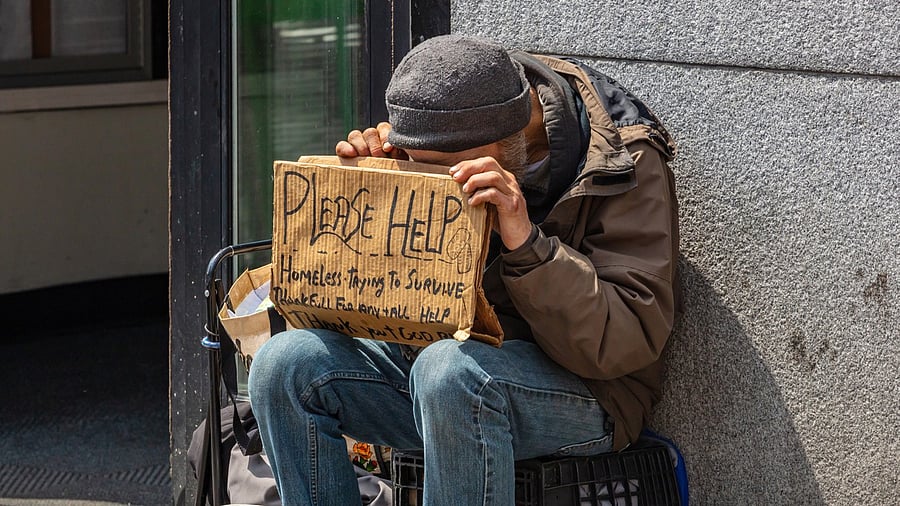
Homeless man holding a cardboard sign, asking for help in Manhattan downtown. Representative image.
Credit: iStock photo
Despite the world producing enough food to feed its population, hunger continues to afflict millions globally. According to World Health Organisation (WHO) statistics, one in every eleven people worldwide went to bed hungry each night in 2023.
While hunger is often associated with developing regions like Africa and parts of Asia, can you imagine it is also a significant issue in the United States — the so-called land of plenty? This article explores that stark reality.
The US, the largest economy for 134 years and the oldest democracy with a network of welfare programmes aimed at eradicating poverty and hunger, is grappling with food insecurity. The United States Department of Agriculture (USDA) highlights this issue in its report, Household Food Security in the United States 2023.
The report reveals that one in seven US households—comprising 47.4 million Americans, including 13.8 million children—experienced food insecurity. As of December 2024, the US population stands at approximately 346,331,044.
This means about 13.7 per cent of the population, including children, struggles with food insecurity. To put this into perspective, the percentage is comparable to India, where 13 per cent of the population suffers from chronic undernourishment, according to The State of Food Security and Nutrition in the World 2024.
These findings challenge the stereotype of America as a well-fed nation while highlighting food insecurity levels akin to those in India’s poorest regions. In fact, the food insecure population in the US is more than that in Odisha, one of India’s poorest states, as per the 2011 census.
The USDA report further reveals that 5.1 per cent of US households reported very low food security, marked by skipping meals or reducing food intake due to financial constraints. Alarmingly, 98 per cent of the respondents in the USDA survey admitted worrying about running out of food before being able to afford more.
India’s legal framework, such as the National Food Security Act, 2013, ensured food access for all citizens as a constitutional right. Articles 21, 39(a), and 47 collectively affirm the State’s duty to provide adequate nutrition and living standards.
The right to food means that people should be able to access adequate food and a balanced diet without having to compromise on other basic needs. Food should be available to everyone, including citizens, prisoners, children, the sick, and the elderly.
Similarly, Article 11 of the American Declaration recognises the right to food as an integral part of the right to health and well-being, while Article 25 of the Universal Declaration establishes food as a vital element for an adequate standard of living, health, and well-being of people. Yet, both nations face starkly different challenges in ensuring these rights are realised.
Poverty remains persistent in the US. In 2023, about 36.8 million Americans (11.1 per cent of the population) lived below the poverty line—a figure unchanged from the previous year. This raises a critical question: how does a country producing enough food for its population still face widespread food insecurity?
The answer to this vexed question lies in systemic inequality. Among the American food-insecure households, Black communities face the highest rates (23.3 per cent), followed by the Latino households (21.9 per cent). These rates are more than double the 9.9 observed among white households. Geographically, southern states are disproportionately affected. Hunger and malnutrition remain leading causes of death and disability in the US.
To address the above question, the 2022 White House National Strategy on Hunger, Nutrition, and Health set an ambitious goal to end hunger in America and increase healthy eating and physical activity by 2030.
Is there systemic racism that drives this dismal situation?
Food insecurity disproportionately affects Black and other socially disadvantaged groups, underscoring the role of structural barriers and systemic racism. Forty percent of Americans live just one pay cheque away from poverty, forcing impossible choices between feeding their families and paying for other necessities.
Black populations, in particular, face these inequities due to low-paying jobs, underemployment, and limited access to government benefits.
President Abraham Lincoln famously described democracy as “of the people, by the people, and for the people” in 1863 during his famous Gettysburg Address. Nearly three centuries later, systemic inequities make democracy elusive for many, especially Black Americans.
(The author is a former professor with The Royal Society, Belgium)